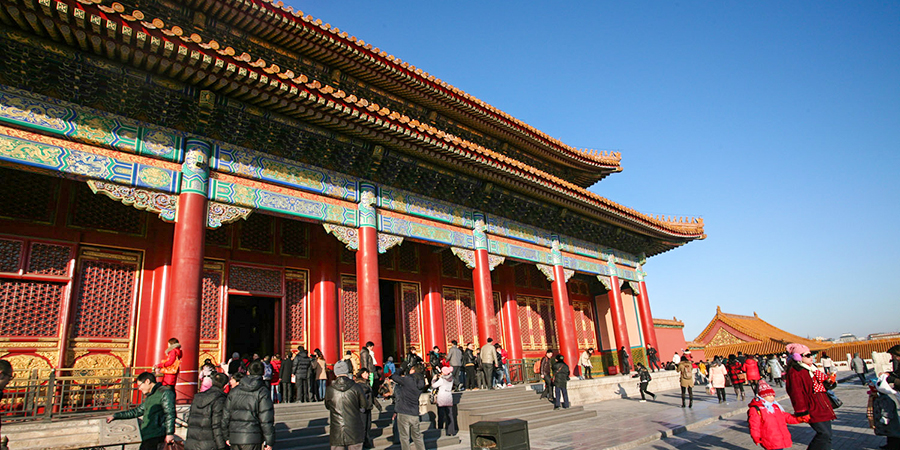Palace of Compassion and Tranquility (Cininggong)
The western area of the Forbidden City in Beijing, called “the World of Women”, is a place where wives of late emperors lived during the Ming (1368-1644) and Qing (1644-1911) Dynasties. In accordance with feudal manners, emperors should not live with the wives of late emperors. Thus, the Palace of Compassion and Tranquility, also known as Cining Palace, was constructed in order to house them. Additionally, great ceremonies were held here to bestow titles of honor upon empress dowagers, to celebrate their birthdays, or to temporarily lay their bodies after they had passed away.
Located to the west of the Gate of Great Ancestors (Longzongmen) in the Inner Court of the Forbidden City, the Palace of Compassion and Tranquility is the essence of ancient palace architecture. It was first built in the fifteenth year (1536) of the Jiajing reign of the Ming Dynasty and was most prosperous in the early and middle Qing Dynasty when Empress Dowager Xiaozhuang, a famous woman politician, dwelled here.
Despite its eminent station in the past, the palace has been used as a storehouse since the Forbidden City was opened to the public in 1925. It has concealed its mystery for years. Presently, the Gate of Great Ancestors (Longzongmen) has been transformed into a service center, through which tourists visit the palace, the Garden of Compassion and Tranquility, the Grand Hall for Worshipping Buddha (Dafotang) and the Palace of Longevity and Good Health.History
 |
Functional Shift
The Hall of Compassion and Tranquility serves as a sculpture hall. More than 400 rare cultural relics are on display, including 91 national treasures.
Layout
In front of the Hall of Compassion and Tranquility lies a narrow square which runs from east to west. The Gate of Compassion and Tranquility (Ciningmen) stands to the north of the square. Going through the gate, one will find a terrace which leads to the Hall of Compassion and Tranquility on which four bronze gilded incense burners are placed. Directly above the hall hangs two horizontal scrolls bearing inscriptions written by Emperor Qianlong.
The hall has a double eave roof decorated by yellow glazed tiles. It has seven rooms in total. Both of the two side rooms have four exquisite wood windows, while all the five rooms in the middle have four elaborate wood doors. On either side of the hall is a festoon gate which leads north to the Grand Hall for Worshipping Buddha (Dafotang).
As the largest hall for worshipping Buddha in the Forbidden City, the Grand Hall has seven rooms decorated with yellow glazed tiles. There are exquisite incense burners placed on the platform before the hall. In the hall, one can find various images of Buddha, pagodas, Buddhist scripture reels and musical instruments used in Buddhist ceremonies. The statues of the eighteen arhats are the most precious. At present, the building is well preserved while the figures of Buddha have been moved to the White Horse Temple in Luoyang, Henan Province for preservation.
To the south of the narrow square stands the Garden of Compassion and Tranquility, where empress dowagers spent plenty of time strolling and relaxing. Even today, the garden is still tranquil and peaceful.
The main building in the garden is the Hall of Inherence (Xianruoguan) decorated with yellow glazed tiles, which is surrounded by three subordinate halls with green glazed tiles. In the south of the garden exists a rectangular pool, across which a white marble bridge arches. On either side of the pool stands a flower terrace planted with peonies. There are many kinds of trees in the garden, including pines, cypresses, phoenix trees, and ginkgo trees.
The garden presents different landscapes at different seasons and makes people delighted and relaxed.
Go east back to the Qianqingmen Square and continue the tour along the central axis. Enter through the Gate of Heavenly Purity (Qianqingmen) to see the three major halls of the Inner Court.
Go west to the Hall of Longevity and Good Health (Shoukanggong); go east to the Hall of Mental Cultivation (Yangxindian).
How to visit the Forbidden City
The One and Only Lunar Dial in the Forbidden City
4 Plaques with 3 Languages in the Forbidden City
Special Caisson Ceiling Designs in the Forbidden City
- Last updated on Sep. 25, 2024 by Gabby Li -